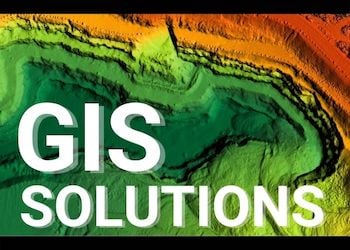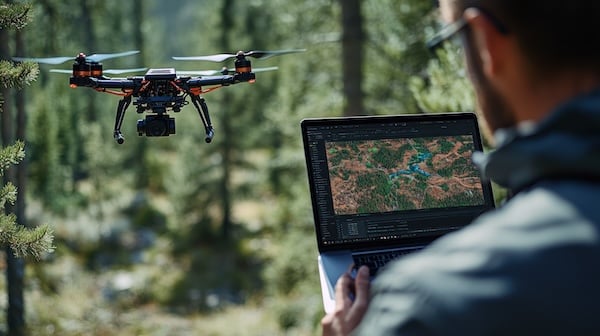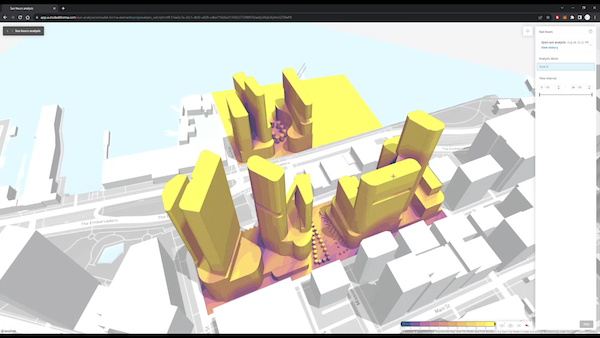
Handheld data collectors are streamlining GIS processes and offering features once only available in bulky multi-component systems. Along the way, evolving technologies are blurring lines that once distinguished GIS from surveying, opening doors for more data sharing and collaboration.
American Electric Power, a Columbus, OH-based utility that uses handheld data collectors on a widespread basis, is implementing Trimble’s new TDC650, a combined receiver and data collector that offers new levels of accuracy and portability. AEP has found that the TDC650 can achieve unprecedented accuracy in locations ranging from rural areas with limited communications infrastructure to urban areas with high-rise buildings and other potential interference sources.
“We’re able to get precise locations where we hadn't been able to in the past,” said Matt Tackett, senior engineering technician with AEP. He cited an example of testing the TDC650 near the company’s headquarters, located in a 31-story building in Columbus. With previous equipment, horizontal location accuracy adjacent to the building was limited to approximately 5 meters due to signal reflection, but with the TDC650, AEP has achieved repeatable accuracy to within 0.5 meters immediately adjacent to the building.

Utility company American Electric Power is implementing the Trimble TDC650 in several of its operating companies. Image source: AEP.
New Technology in a Smaller Package
Trimble designed the TDC650 to provide different levels of accuracy, depending on user needs, according to Mathias Roehring, market manager, GIS and mapping hardware solutions, Trimble Inc. The unit can be configured for four different levels of accuracy, ranging from 1 meter down to 1 centimeter. Users select the accuracy level at purchase time.
“It’s a device built for purpose but flexible enough to address a huge variety of customers with different needs,” said Roehring. For example, a forestry professional mapping tree locations might require less accuracy than an archaeologist mapping artifacts in an excavation site, he noted.
In addition to functioning as a handheld unit, the TDC650 can be mounted on a monopole for more precisely locating points. And, while the unit contains a built-in antenna, it can be connected to an external antenna in areas with interference or features obscuring satellite views. Those optional, external connections were previously mandatory to achieve the results now available with the TDC series.

The Trimble TDC650 can be configured for different levels of accuracy, depending on end user needs. Image source: Trimble.
The TDC650 is also designed to simplify setup processes, according to Roehring. “You have the receiver, the battery, the display, and the computing part all integrated in one handheld,” noted Roehring. “You don't have to do a lot of configuration. There's a lot of automation going on in the background, in the firmware, and the receiver takes care of all that and optimizes your results. You don't need to know about satellites orbiting anymore. The customer can focus on their job.”
Built for the Android operating system, the TDC650 features a six-inch screen—slightly larger than its predecessor, the TDC150—yet the TDC650 weighs less than the TDC150—790 grams vs. 850 grams. The TDC650 is fitted with two distinct global navigation satellite systems (GNSS) location providers: the u-blox Android GNSS for low accuracy and the Trimble high-accuracy GNSS module for more accurate readings.
The GNSS term, which is becoming more prevalent in geospatial discussions, refers to any satellite constellation that provides positioning, navigation, and timing (PNT) services on a global or regional basis, according to GPS.gov, a U.S. government web site. The US-operated GPS is one such GNSS. Most GNSS-based devices obtain basic location information from satellites and rely on terrestrial-based corrections or augmentations to compensate for various imperfections and improve accuracy. The TDC650 can use several types of corrections, depending on accuracy levels, and can perform corrections in near real time, an important consideration for users such as AEP.
“One of the things we've noticed with the device is that it gets its corrections considerably faster than what we had done in the past,” said Tackett. “Instead of needing two to three minutes to get settled on a location, we're able to actually get it down to less than a minute in a lot of cases.”
Integrating Data Into the Workflow
Another important factor for AEP is integrating field data into the GIS and engineering workflows. In this regard, Tackett sees the TDC650 working similarly to other data collectors AEP has used. Because AEP’s primary design and engineering software, Distribution Design Studio (DDS) from GeoSpatial Innovations, Inc., is designed to work with Trimble devices, he says AEP field personnel can collect data efficiently with the TDC650 much as they have in the past.
As an example, he cited a worker collecting data on a utility cross arm with a three-phase electrical line on top. Using the TDC650, the worker can enter those attributes in the data collector and the DDS software interprets the information and incorporates it directly into the design system. With the ability to include attribute information during data collection, “we're able to more quickly process that information,” said Tackett.
He sees similar seamless integration of field data into AEP’s GIS, which is based on Esri’s ArcMap and ArcGIS software. GIS data is routinely transmitted both to and from AEP field operations. “We translate data over from the GIS and we interact with Esri products on a regular basis,” noted Tackett. AEP also developed an internal application built on the Esri platform to aid users interacting between GIS and field operations. After a project goes to construction, design information is transferred to AEP’s GIS department, where it is maintained and updated based on as-built information.

Attributes for utility structures and other features can be entered while collecting location information. Image source: Trimble.
Convergence of Technologies
As handheld data collectors have provided more accuracy and become easier to use, roles have overlapped between GIS, survey, and engineering professionals, according to Trimble’s Roehring. In its early days, GIS was often detached from surveying and generally dealt with high-level, low-accuracy data. As technology developed, that has changed, he noted. “GIS became omnipresent, and now everyone is using GIS to some extent. It was enabled by this convergence of different technologies.”
AEP’s Tackett also looks for improved accuracy to trickle down to consumer-grade devices such as smart phones, but for now, those devices are not a viable option for AEP, as they require additional equipment to achieve the desired results. The all-in-one handhelds, with minimal setup and the ability to achieve decimeter accuracy, provide the best solution for AEP. “Most of our users prefer an all-in-one. It’s really quick. You fire it up and go collect [data],” he said.
All-in-one handhelds such as the TDC650 open new doors for GIS professionals seeking to gather location data quickly and at higher levels of accuracy than in years past. The new devices do not eliminate the need for more precise surveys for processes such as final design and construction of infrastructure projects, but the handhelds present interesting prospects for those considering new data collection options.
Andrew G. Roe
Cadalyst contributing editor Andrew G. Roe is a registered civil engineer and president of AGR Associates. He is author of Using Visual Basic with AutoCAD, published by Autodesk Press. He can be reached at editors@cadalyst.com.
View All Articles




Searching for more information about Architecture, Infrastructure, and Construction?
Click here!